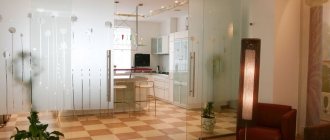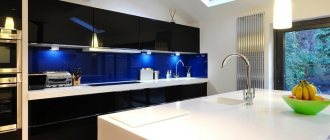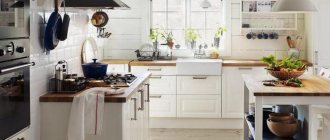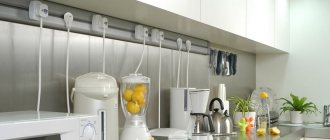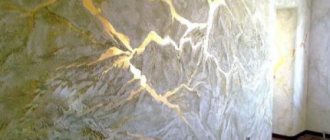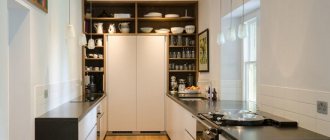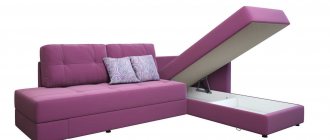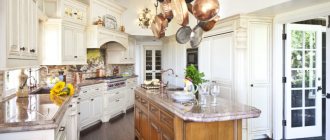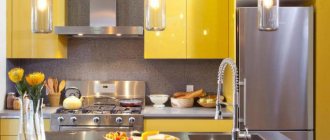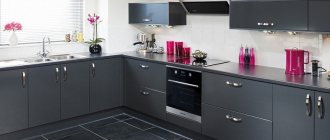Modern kitchens are increasingly designed as a single space with a dining room or living room, so the appearance of the kitchen, which should always look neat and stylish, is becoming important. To prevent splashes of grease, drops of water and stains from spoiling the appearance, it is customary to cover the work area in the kitchen with an apron, which protects the wall between the wall and floor parts of the furniture set. Designers suggest using glass aprons for the kitchen; photos of interesting design options can be seen below.
Pros and cons of glass splashbacks
Compared to MDF, plastic, ceramic tiles, glass panels have a number of advantages.
- Composting fallen leaves
Read
- Glass panels, or, as they are also called, skinels (from the English word “to sheathe”) have become popular due to the variety of designs. Any designs in any color, including three-dimensional ones, can be transferred to this type of coating. With the help of glass panels, the room is quickly updated and transformed, filled with bright colors. For a small kitchen, glass panels are an ideal solution, because they visually increase the space.
- Due to special processing, the glass is resistant to chemical, mechanical and temperature influences, the panels have a long service life.
- Glass, unlike other materials, does not have a porous surface, so grease and dirt are not absorbed, and cleaning can be done quickly and without much hassle. The glass panels on the kitchen apron are a monolithic slab, so there is no problem of dirty seams.
- Safety is of no small importance. Treated glass has increased strength, excellent resistance to mechanical damage. If the blow is strong, then the glass, breaking, does not fly into fragments, but crumbles.
- Easy to install structure.
Glass decorative panels also have disadvantages, which it is preferable to know about before purchase and installation:
- the cost is higher than other coatings;
- Fingerprints and stains remain on the glass due to poor cleaning;
- After installation it is not possible to install additional sockets.
Mirror apron for the kitchen and its advantages
From the point of view of practical application, a mirror apron has a lot of undeniable advantages , which precisely contribute to its popularity.
- The mirror surface is absolutely insensitive to high temperatures. Boiling water, hot fat and even the proximity of the gas burners of the stove do not in any way affect the apron. Tempered glass can easily withstand such loads.
- An apron made of this material does not absorb water at all. Moisture, steam, water flows, dirt, grease and soot will not harm the mirror apron in any way. It is enough to wipe it with a damp sponge and then with a dry cloth, and the surface will again shine with its pristine beauty.
- Mirror tiles or panels are inert to almost all chemical influences that occur in the kitchen. Neither household chemicals, nor food acid, nor bleach will damage durable tempered glass.
- Such an apron will be absolutely inert to biological influences. What does this mean? There is simply no chance for mold or mildew to grow. They will not be able to appear on a mirrored apron.
- Environmentally friendly material and complete safety for humans. Glass - even when heated strongly - does not release any substances that can harm us. Plus, it doesn't support combustion or decomposition of food waste - meaning no unpleasant odors! What makes a mirrored apron one of the most pleasant options for decorating a work wall.
- In addition to all of the above, such an apron is not afraid of sponges and brushes, it is pleasant and easy to care for, since the smooth, polished surface is quickly cleaned even from heavy dirt. Do not use abrasive materials for mirror aprons. For example, fine sandpaper would be a poor choice.
Types of glass for kitchen splashbacks
Glass tiles for backsplashes are made from different types of glass, which determines the performance characteristics of each type of this finishing coating.
What kind of glass is used:
- Stalinite. Special heat treatment increases the shock resistance of the glass and extends its service life to 20 years. The material is not afraid of high temperatures and treatment with abrasives, its thickness is 6-8 mm. A type of tempered glass is Optiwhite, in which the surface is bleached to complete transparency, which improves the quality of the image that is applied to the back surface of the panel (painting or photo printing).
- Triplex is laminated glass. They are made from several layers of silicate or tempered glass, glued with a polymer composition. This glass is especially durable, its thickness is 8 mm. The internal polymer film allows you to diversify the decorative qualities of the apron; the image is protected by glass on both sides, located between the layers.
- Plexiglas is made from polymethyl methacrylate or acrylic. The thickness varies and the panel is flexible enough to fit on curved or uneven surfaces. When caring for such a surface, you cannot use abrasives; plexiglass does not tolerate temperatures above +80°C, so it is not used above the hob.
- Polycarbonate. Just as plexiglass is a polymer material, their main characteristics are the same. But polycarbonate glass is more resistant to temperature effects.
- Ordinary glass. The thickness is 4 mm, which does not guarantee impact resistance and safety. The image (wallpaper, self-adhesive film) is glued to the wall or the back of the glass.
- Glass mosaic is another option for an unusual wall design above the work surface. Original wall panels are laid out from mosaic elements using modules or individual tiles. A popular mosaic option is 50x50 cm squares. The material is often combined with smooth or textured surfaces.
Glass splashback for a modern kitchen
Features of glass finishing
Glass kitchen aprons have characteristics that ensure high durability and long service life. They do not absorb odors and are not hazardous to human health. The absence of irregularities and joints prevents the accumulation of dirt.
The sizes are in the ranges:
- length – 0.6-2.5 m;
- thickness – 6-8 mm;
- height – 40-90 cm.
It is recommended to use tempered glass for the work area. It is several times stronger than usual. The advantage of this material is safety. Tempered glass for the kitchen is a durable and reliable coating, and if it breaks, the fragments will not cause harm.
A good solution is to use bleached Optiwhite glass. It is more transparent than usual. The drawing on it looks brighter. A glass kitchen apron is matched to the color of the furniture or a contrast technique is used. A unique design is obtained by installing the backlight.
Advice ! You can place photographs, recipes, beautiful fabrics, and drawings under glass.
A distinctive feature of glass panels for the kitchen is the large number of decor options. It is possible to create various original effects.
Decor
Depending on the interior design, the type of treatment and decoration of the skinnel is selected. The following types exist:
- transparent – the texture of the wall is preserved, its pattern is visible (wood, brick, stone);
- matte – the tone and color of the design look softer and calmer;
- tinted – translucent glass creates a hazy effect;
- painted - manufacturers offer both plain and multi-colored options;
- foil fabric;
- mirror – tinted, aged or with a pattern.
Glass apron - sunflowers
The image is applied to a kitchen glass apron in different ways:
- ornaments and patterns are created using the sandblasting method;
- the pattern on the vinyl film is glued to the back surface of the glass;
- photo printing.
Glass apron - tulips in the kitchen interior
Photo printing
Glass aprons for the kitchen with photo printing are one of the most popular types, despite the fact that the price for this type of finish is higher.
Design of a kitchen apron with photo printing - flowers in pots
How to apply photo printing:
- The glass is cut to size and technological holes are made.
- The drawing is printed on a special machine.
- Photo printing is covered with a protective film.
Using this method, you can apply any image that suits the kitchen interior.
Glass apron for the kitchen with photo printing
Features of the material
An apron in the kitchen is primarily needed to protect the wall above the work surface from dirt. It is almost impossible to clean plaster or wallpaper from traces of grease or limescale stains. Traditionally, ceramic tiles are used to cover the wall above the work area, but materials such as artificial stone, tempered glass, plastic and metal have already taken root in modern design. Mirrored kitchen splashbacks look incredibly stylish. They fit organically into any design direction, be it minimalism, hi-tech, loft or classic.
Mirrored aprons for the kitchen (photo below) are made of tempered glass. Its feature is increased strength and safety. Even if the apron breaks, no one will get hurt: it crumbles into small, non-sharp fragments.
Manufacturers offer both light mirrors for cladding and tinted ones. An apron with a golden tint will look attractive with wooden facades of a kitchen set or a countertop, and with a black one in a kitchen in a minimalist style. For a classic interior, a mirror version with matte patterns obtained by etching technology, or artistic painting using stained glass technique, is suitable. Of course, decorated surfaces are more difficult to care for than a smooth mirror panel.
Such material is used in the interior to expand the space, so when decorating a small kitchen, such an apron will come in handy. A reflective surface will also help improve the proportions of the room. For large kitchens, preference should be given to mirror tiles or mosaics. Their shape may vary.
A mirrored apron for the kitchen will make the room brighter. Several built-in lamps above the surface can replace local lighting of the entire area. Mirrors will “double” the number of light sources.
Glass apron in the interior
It is important to choose the right color scheme for glass panels, which should contrast with the furniture facades and decoration of the room or harmoniously complement and shade them. Black and white images look impressive.
Glass splashback for the kitchen with blue flowers
Aprons with thematic compositions look interesting:
- culinary theme - fruits, bottles of wine, exotic dishes;
- architectural pictures, color or graphic;
- landscape views;
- marine species;
- flower arrangements;
- geometric designs;
- reproductions of famous paintings, still lifes and landscapes;
- neutral pictures – water drops, coffee beans, night city.
Glass apron for the kitchen
Transparent panels that cover a textured background - leather, stone, brickwork, fabric folds - look original. The choice of glass panels is large, so you need to get advice from a specialist and choose the best option so that your money is not wasted.
Blue apron in the kitchen interior
Types of apron
Plain aprons usually fit into any colorful interior, giving it calm and regularity. If the style of the kitchen is in contrasting, not sharp tones, then a plain canvas will also fit best. You can find a photo of a glass apron that you like directly on the Internet or look at it from famous designers, creating your own interpretation.
A white glass apron is always a good solution; it adds freshness, cleanliness to the kitchen area, and visually increases the space. After its installation, minimal maintenance will be required, since it is easy to spot a stain on white, and it will be easy to wipe it off. Therefore, maintaining cleanliness will not take you much time and effort.
In addition to white, you can choose shades of blue, beige, and gray. Most designers call these colors basic, universal and give them preference, visually zoning the space.
By choosing the right coating, even the smallest simple kitchen can be presented as art.
Lighting
Important! Proper lighting of glass panels is required to make a kitchen with a glass apron from the photo look more advantageous, stylish and cozy.
Use:
- LED strip;
- LED lamps;
- spot lighting.
The light is placed from above or below.
Ice cubes with mint - photo printing on an apron for the kitchen
Cost calculation
You can independently calculate the cost of a glass apron; the price is influenced by the following factors:
- canvas dimensions;
- type of glass;
- method of applying the image;
- installation option;
- installation and type of lighting;
- the presence of additional holes.
Glass apron for the kitchen with a picture of green grass
Glass panels are produced in different sizes:
- length 0.6-3 m;
- width 0.4-0.9 m.
Important! The dimensions of the glass apron must be measured after final finishing and placement of furniture. In order to hide the fastenings, the apron is made 20 cm larger than the surface to be covered.
Modern kitchen design
Complex images increase the cost of a glass splashback:
- budget option - simple glass covering a papered or painted wall;
- glass painted on the back is 20% more expensive;
- 3D drawing doubles the price.
Glass apron kiwi
Installation
How to attach a glass apron? Depending on the situation, specialists use the following methods:
- Screws. With their help, glass is mounted on any surface, and no pre-treatment of the wall is required. You can place skinels on top of the old covering. In this case, a 4-5 mm gap remains between the wall and the apron, and the fastening is decorated with plugs.
- Hanging fasteners. The glass sheet is inserted into metal clamps that press it to the wall. This method is used to align the joints of an apron assembled from different elements.
- Liquid Nails. Use only on a pre-plastered, flat surface, the fasteners are not visible.
Original design of a glass splashback for the kitchen
When installing a glass splashback, experts advise adhering to the following rules:
- Before installing the apron, treat the wall with an antibacterial coating;
- comply with the requirements for the sequence of actions during installation;
- on the combined panel, treat the seams with sealant;
- Close the gap between the kitchen work surface and the stove with a special corner.
A glass splashback decorates the kitchen, while at the same time serving as a functional means of protecting the wall.
Summer kitchen with designer glass splashback
To avoid missing new articles, subscribe to the site:
Post Views: 474
